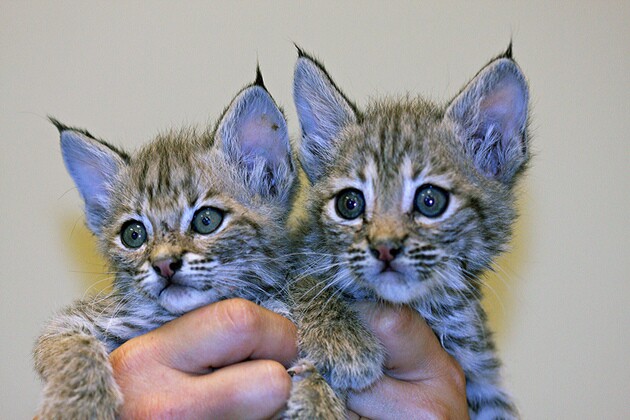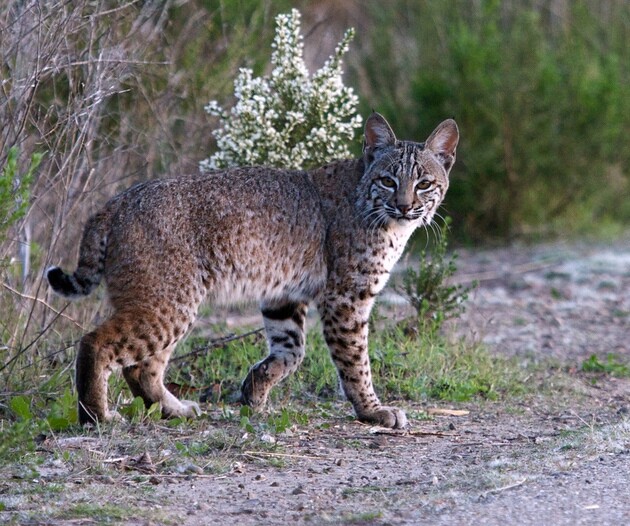It's Official: Bobcat Trapping Banned in California

Three years in the making, but only four days before the opening of what would have been the 2015 season, bobcat pelt trapping becomes illegal in California as of November 20.
Thus ends a circuitous journey that began in early 2013 when a citizen of a small rural community stumbled upon a bobcat cage, triggering awareness that state policies allowed bobcats to be harvested in unrestricted numbers. Many Californians found the mere legality of trapping bobcats to be outrageous.
Public outcry landed on the ears of Assembly Member Richard Bloom, whose Bobcat Protection Act of 2013 (AB1213) began its trek through the minefield of the legislative process with the goal of a statewide ban of pelt trapping of bobcats. But in order to navigate obstructions and reach the Governor's desk, the bill required modifications that downplayed bobcats and brought human-centric issues to the foreground.
First, private property owners were covered against trapping on their lands without explicit consent. Secondly, by requiring buffer zones around protected areas, predators with home ranges in parks and refuges were far less likely to be depleted by the use of traps along park boundaries.

A third key element shifted the fiscal burden of the bobcat trapping program from the state onto bobcat trappers by mandating that the bobcat trapping become self-funding. Low tag and license fees had essentially subsidized the profits of around one hundred trappers in a state of thirty-eight million.
The compact three-page bill concluded with a brief provision outlining the prerogative of the California Fish and Game Commission and the California Department of Fish and Wildlife (CDFW) to enact further prohibitions, including a complete ban, and as amended AB1213 moved smoothly through the legislature to be signed into law by Governor Brown less than a year after the trap was found.
Brown's brief signing statement implicitly encouraged protections for bobcats and suggested that the legislature might seek funding for a bobcat study, most likely unaware of the $1.8 million estimate that had been projected earlier by CDFW. Passing along this cost to either taxpayers or to a handful of bobcat trappers would have been wildly impractical. In any event, no funding was sought, no survey was initiated, and the job of interpreting the statutory abstractions of the bill into the nuts and bolts of regulatory language was kicked down the road to the Commission and CDFW. In October 2014, bobcats began their turn on the Commission's agenda wheel.

Attending Fish and Game Commission meetings produces a mind-blowing respect for the complex tasks brought before the appointed Commissioners. Thirty or so time-sensitive items come under consideration at every meeting, the bulk of which reflect the distress in which we currently find our terrestrial, aquatic, and climatic environment. By scheduling meetings around the state, the public meeting process is intelligently designed to collect a diverse sampling of geographic and demographic concerns. Although public comments are typically delivered by the handful of professional lobbyists and paid conservationists who regularly work this circuit, occasionally three, four, or even a dozen citizens might weigh in on a topic. Sometimes there are no speakers at all.
Events unfolded differently for the bobcats. In preliminary discussions on how to tackle regulating AB1213, a Commissioner resurrected earlier hopes for a statewide ban by moving that a moratorium on bobcat trapping be one of two options under consideration. Citizens responded explosively through petitions and correspondences, and news rippled outward to national groups with their heavy hitting supporter bases, as speaker lines grew longer at each meeting; twenty, then forty-five, then seventy, with an accumulation of letters, comments, and signatures numbering in the tens of thousands. In final discussion meetings a few months prior to the vote, the pendulum's direction was apparent.
Just as a quorum for bobcats seemed certain, Governor Brown replaced the Commission's two most outspokenly predator-friendly members. It's conjecture as to whether the timing of these dismissals coincided with routine appointments, or if the changes were a response to the national sportsmen's groups that had been openly seeking to "change the complex face of the California Fish and Game Commission." Compounding the eleventh-hour switch, the final vote took place in the pro-trap hotbed of the northern counties.
Those who objected to having the state's bobcats trapped, exported, and turned into mittens then re-doubled their efforts.

Over 100 people filed into the auditorium in Fortuna last summer, settling into the sea of banquet chairs, standing in the entrances, and sitting cross-legged along the room's carpeted sides, ready to address the Fish and Game Commission. About twelve spoke against a ban, while the remainder presented an avalanche of reasons why bobcat trapping was not allowable under their watch. The Commissioners presented weighty monologues. With no prior indication of the outcome, the vote was taken and on August 5 the ban was adopted.
But before becoming official, the new bobcat regulations had to be published by the Office of Administrative Law (OAL), leaving wiggle room for delay or mishap. The OAL publishes on a quarterly basis with a procedural requirement that every comment be notated, and the very mountain of support that had propelled the ban to success was now jeopardizing the closing of this year's bobcat trapping season. In order to meet the hair's-width deadline, staff was added and the new ban regulations were published by the OAL last Friday, and will finally become official November 20.

This chapter of California wildlife history closes on a celebratory note, with our government moving in tandem with the pervasive will of its constituents by realizing the original intent of a law that was passed over two years ago. But our happy story has a dark sidebar, as prohibitions historically produce a degree of illicit trade. Until wildlife crimes are duly prosecuted, we must take care not be lulled into complacency on the basis of legislative advances alone. Californians made protecting bobcats a priority, so surely we can amplify this achievement by demanding enforcement of wildlife protection laws.
Why did bobcats pack the house when all species deserve the same turnout? Prohibiting bobcat trapping allows us to rise above our past of taking heedlessly until only slap-dash mitigation and loss remain. Bobcat trappers are hardly the only members of our society to blame, since none of us can relinquish the homes and the roads that are the basis of our survival, and the ongoing habitat fragmentation that results has already contributed to the subtler lethal damage of genotype depletion.
Although these are fights that we must also undertake, it can be a heavy-hearted exercise to grapple with protecting a handful of mountain lions from our freeways and our rat poisons, to keep a single pack of wolves free from persecution, or to stop our rabbits and centennial tortoises from being used for target practice. But perhaps enough people, heartsick over their inability to remove themselves from the core of every wildlife problem, saw the case of the bobcat as a clear opportunity to act rather than to despair.
Commentaries are the opinions of their authors, and do not necessarily reflect the views of KCETLink.